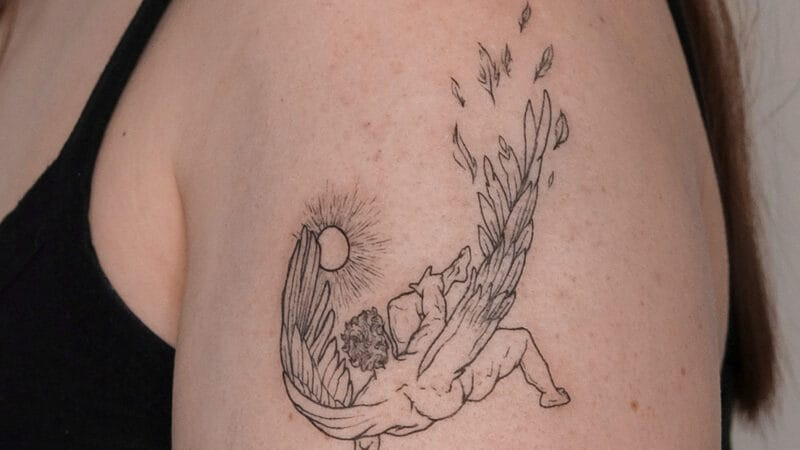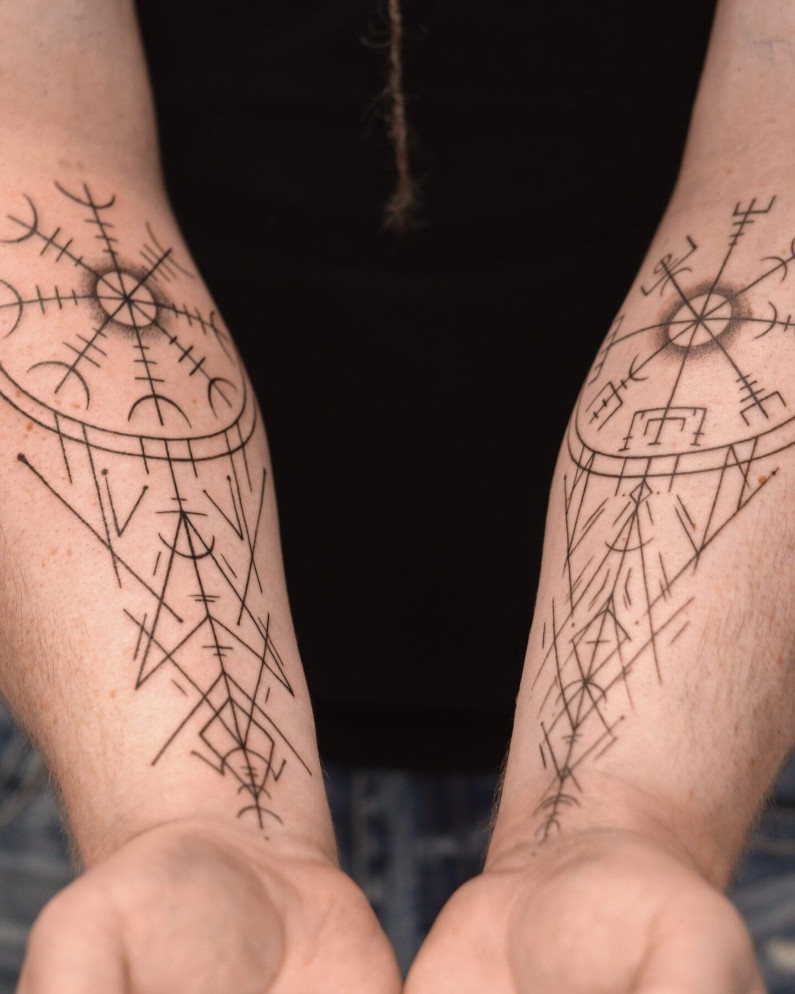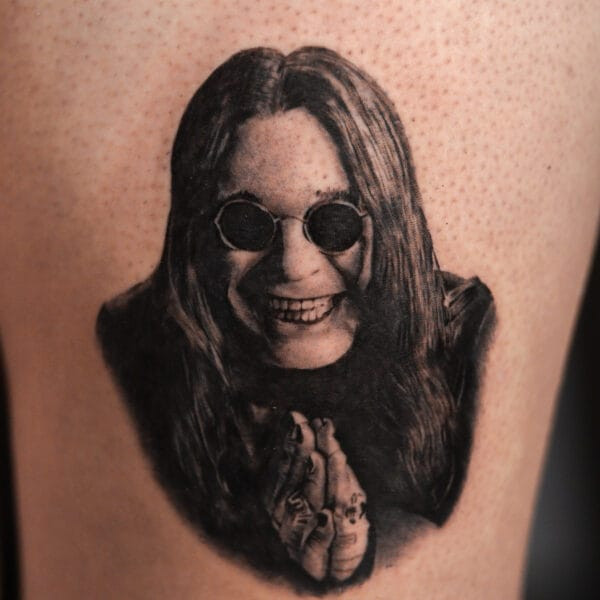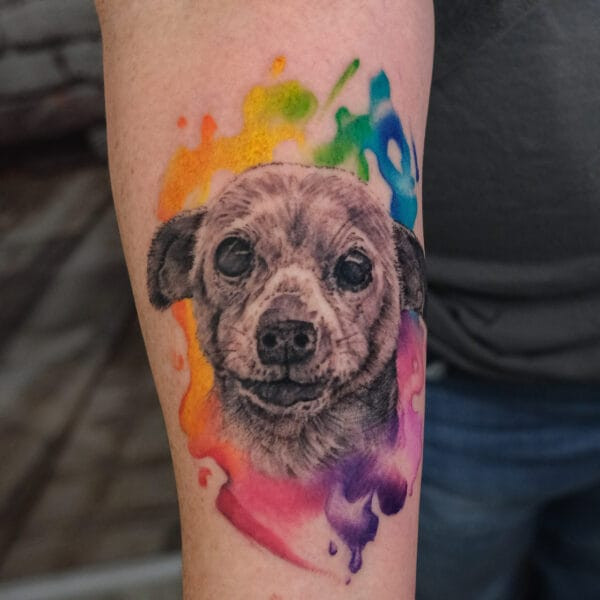How much does a 5-inch tattoo cost? The price of a 5-inch tattoo can vary quite a bit, but at tattooat.com, we will break down all of the influencing factors for you. Expect to pay anywhere from $300 to $800, depending on the artist’s experience, the complexity of the design, and the body placement; understanding these elements is key to budgeting for your body art. Let’s explore size, intricacy, and placement, and discover how these aspects influence tattoo prices so you can estimate costs effectively and find the perfect artist for your vision.
1. What Factors Determine the Cost of a 5-Inch Tattoo?
The cost of a 5-inch tattoo is influenced by several key factors, including the artist’s skill level, design complexity, body placement, and studio fees. Let’s dive into each of these to give you a clearer picture.
1.1. Tattoo Artist’s Skill Level and Experience
The experience level of your tattoo artist is a significant cost factor. Artists with more years under their belt, specialized skills, or high demand for their work can command higher rates.
| Artist Level | Hourly Rate | Experience Level |
|---|---|---|
| Junior Artist | $50 – $130 | 1-3 years, building portfolio |
| Experienced Artist | $150 – $300 | 5+ years, refined skills, handles intricate work efficiently |
| Pro Artist | $300 – $500+ | Award-winning, recognized in the tattoo community |
Choosing the right artist depends on your budget and the complexity of your design. While a junior artist might offer a lower hourly rate, an experienced or pro artist can provide a higher quality tattoo with finer details.
1.2. Design Complexity and Details
The intricacy of your tattoo design plays a crucial role in determining the final cost. A simple, minimalist design will generally cost less than a highly detailed, custom piece that requires more time and expertise.
- Simple Designs: These involve basic outlines, minimal shading, and fewer colors. They require less time and skill, making them more affordable.
- Detailed Designs: These include complex patterns, extensive shading, multiple colors, and custom elements. They demand more time and precision, leading to higher costs.
For example, an outline of a flower will cost significantly less than a full-color, realistic portrait of the same flower.
1.3. Body Placement
Where you choose to place your tattoo can also affect the price. Some areas are more difficult to tattoo, requiring more time and skill, while others are relatively straightforward.
- Difficult Areas: These include ribs, neck, hands, fingers, and face. Tattooing these areas can be more challenging due to sensitive skin, bone proximity, and frequent movement. Artists often charge higher rates for these placements.
- Easier Areas: These include arms, legs, and back. These areas offer more surface area and are generally easier to work on, resulting in potentially lower costs.
1.4. Studio Fees and Minimum Charges
Most tattoo studios have a minimum charge to cover setup costs, materials, and sterilization procedures. This minimum fee applies even to very small tattoos. Additionally, some studios may include extra fees for consultations, custom designs, or specific equipment usage. Always clarify these fees upfront to avoid surprises.
2. How Much Should You Budget for a 5-Inch Tattoo?
Budgeting for a 5-inch tattoo involves considering the artist’s hourly rate, the estimated time for the tattoo, and any additional fees. Here’s how to approach it:
2.1. Average Cost Range for a 5-Inch Tattoo
For a 5-inch tattoo, you can generally expect the following price ranges based on the artist’s skill level:
| Artist Level | Estimated Cost for a 5-Inch Tattoo |
|---|---|
| Junior Artist | $300 – $650 |
| Experienced Artist | $750 – $1500 |
| Pro Artist | $1500+ |
These are rough estimates, and the actual cost may vary depending on the specifics of your design and the studio’s pricing policies.
2.2. Factors That Can Increase the Price
Several factors can push the price of your tattoo higher than the average range:
- Intricate Designs: Highly detailed designs with complex shading and multiple colors will require more time and skill, increasing the cost.
- Custom Artwork: If you’re commissioning a custom design, the artist may charge extra for the design process.
- Difficult Placement: Areas like the ribs, neck, or fingers are more challenging and may incur higher rates.
- High-Demand Artists: Popular or award-winning artists often have higher rates and longer waiting lists.
2.3. Hidden Costs to Consider
When budgeting, don’t forget to account for potential hidden costs:
- Aftercare Products: You’ll need to purchase aftercare products like tattoo balm and gentle soap to ensure proper healing.
- Touch-Ups: Depending on how your skin heals, you may need a touch-up to correct any imperfections or fading. Some artists offer free touch-ups within a certain timeframe, but others may charge a fee.
- Tipping: It’s customary to tip your tattoo artist, typically 15-20% of the total cost.
3. Examples of 5-Inch Tattoos and Their Estimated Costs
To give you a better understanding of potential costs, here are some examples of 5-inch tattoos with estimated prices, categorized by design complexity and artist level:
3.1. Simple Black Outline Tattoo
A simple black outline tattoo, such as a minimalist geometric shape or a basic floral design, is one of the most affordable options.
- Description: Clean lines, minimal shading, no color.
- Placement: Arm, leg, or back.
- Estimated Cost with Junior Artist: $300 – $450
- Estimated Cost with Experienced Artist: $450 – $600
- Image:
 Simple black outline tattoo on the arm depicting a minimalist geometric shape.
Simple black outline tattoo on the arm depicting a minimalist geometric shape.
3.2. Detailed Black and Gray Shaded Tattoo
A black and gray shaded tattoo involves more intricate shading techniques to create depth and realism.
- Description: Detailed shading, varying tones of black and gray, no color.
- Placement: Shoulder, calf, or thigh.
- Estimated Cost with Junior Artist: $450 – $600
- Estimated Cost with Experienced Artist: $600 – $800
- Image:
 Detailed black and gray shaded tattoo on the shoulder featuring intricate shading techniques.
Detailed black and gray shaded tattoo on the shoulder featuring intricate shading techniques.
3.3. Full-Color Illustrative Tattoo
A full-color illustrative tattoo includes vibrant colors and detailed imagery, often resembling a painting or illustration.
- Description: Multiple colors, detailed imagery, artistic style.
- Placement: Arm, leg, or back.
- Estimated Cost with Junior Artist: $500 – $700
- Estimated Cost with Experienced Artist: $800 – $1200
- Image:
 Full-color illustrative tattoo on the leg with vibrant colors and detailed imagery in an artistic style.
Full-color illustrative tattoo on the leg with vibrant colors and detailed imagery in an artistic style.
3.4. Realistic Portrait Tattoo
A realistic portrait tattoo requires a high level of skill to capture the likeness and details of a person or animal.
- Description: Highly detailed, realistic depiction of a person or animal, often in black and gray or color.
- Placement: Shoulder, back, or thigh.
- Estimated Cost with Junior Artist: $600 – $800
- Estimated Cost with Experienced Artist: $900 – $1500
- Image:
 Realistic portrait tattoo on the thigh with high detail and lifelike depiction of a person.
Realistic portrait tattoo on the thigh with high detail and lifelike depiction of a person.
3.5. Complex Watercolor Tattoo
A watercolor tattoo mimics the style of watercolor paintings, with soft blends and vibrant colors that appear to flow across the skin.
- Description: Soft color blends, flowing design, watercolor effect.
- Placement: Arm, leg, or back.
- Estimated Cost with Junior Artist: $500 – $700
- Estimated Cost with Experienced Artist: $800 – $1200
- Image:
 Complex watercolor tattoo on the arm with soft blends and vibrant colors mimicking a watercolor painting.
Complex watercolor tattoo on the arm with soft blends and vibrant colors mimicking a watercolor painting.
4. Tips for Finding a Tattoo Artist and Getting an Accurate Quote
Finding the right tattoo artist and getting an accurate quote involves careful research and clear communication. Here are some tips to guide you:
4.1. Researching Tattoo Artists and Studios
- Online Reviews: Check online reviews on platforms like Google, Yelp, and tattoo-specific websites. Look for consistent positive feedback regarding the artist’s skill, hygiene, and customer service.
- Portfolios: Review the artist’s portfolio to ensure their style aligns with your vision. Pay attention to the quality of their linework, shading, and color saturation.
- Studio Reputation: Choose a studio with a solid reputation for cleanliness and safety. Look for certifications and adherence to health regulations.
- Word of Mouth: Ask friends, family, or acquaintances who have tattoos for recommendations. Personal referrals can provide valuable insights.
- Social Media: Utilize social media platforms such as Instagram and Facebook to discover tattoo artists and explore their recent work.
4.2. Preparing for a Consultation
- Bring References: Gather reference images of the style, design, and elements you want in your tattoo. The more visual information you provide, the better the artist can understand your vision.
- Be Clear About Your Budget: Discuss your budget openly with the artist to ensure they can create a design that meets your financial constraints.
- Ask Questions: Don’t hesitate to ask questions about the artist’s experience, the tattooing process, aftercare instructions, and studio policies.
- Describe Placement: Be prepared to explain and show where you want the tattoo placed on your body.
4.3. Getting an Accurate Quote
- Detailed Description: Provide a detailed description of your desired tattoo, including size, design complexity, color palette, and placement.
- Ask for a Breakdown: Request a detailed breakdown of the costs, including hourly rate, design fees, and any additional charges.
- Compare Quotes: Get quotes from multiple artists to compare pricing and services. However, don’t base your decision solely on price; consider the artist’s skill and reputation.
- Read the Fine Print: Before committing, read the studio’s policies regarding deposits, cancellations, and touch-ups.
5. Understanding Tattoo Pricing Structures: Hourly vs. Piece Rate
Tattoo artists use different pricing structures, each with its advantages and disadvantages. Understanding these structures can help you make informed decisions and manage your budget effectively.
5.1. Hourly Rates
Many tattoo artists, especially those working on large or complex pieces, charge by the hour.
- How it Works: The artist estimates the time required to complete the tattoo and multiplies it by their hourly rate.
- Pros: Transparent pricing for complex designs, allows for adjustments during the process.
- Cons: Difficult to estimate the final cost accurately, can be more expensive if the tattoo takes longer than expected.
5.2. Piece Rates (Flat Rates)
For smaller, simpler tattoos, artists may offer a flat rate or piece rate.
- How it Works: The artist sets a fixed price for the entire tattoo, regardless of how long it takes.
- Pros: Predictable cost, good for simple designs.
- Cons: May not be suitable for complex or custom designs, less flexibility if changes are needed during the process.
5.3. Factors Influencing the Choice of Pricing Structure
The choice between hourly and piece rates depends on several factors:
- Tattoo Size and Complexity: Larger, more complex tattoos are usually priced hourly, while smaller, simpler ones may have a flat rate.
- Artist Experience: Experienced artists may prefer hourly rates to ensure they are compensated fairly for their time and skill.
- Studio Policy: Some studios have a standard pricing structure that all artists follow.
- Customer Preference: Some customers prefer the predictability of a flat rate, while others prefer the flexibility of an hourly rate.
6. How to Save Money on Your 5-Inch Tattoo
Getting a tattoo is an investment, but there are ways to save money without compromising on quality.
6.1. Choosing a Simpler Design
Opting for a less intricate design can significantly reduce the cost. Simple outlines, minimalist shading, and fewer colors require less time and skill.
- Example: Instead of a full-color portrait, consider a black and gray silhouette.
6.2. Selecting an Appropriate Body Placement
Choosing an easier-to-tattoo area can help lower the price. Areas like the arms, legs, and back are generally more affordable than ribs, neck, or fingers.
- Example: Placing a tattoo on your forearm instead of your ribs.
6.3. Considering a Junior Artist
While it’s important to prioritize quality, a junior artist who is building their portfolio can offer more affordable rates. Look for a junior artist with a style you like and review their portfolio carefully.
- Tip: Ask to see examples of their work on healed tattoos to assess their long-term results.
6.4. Avoiding Custom Designs
Commissioning a custom design can add to the cost. If possible, choose a design from the artist’s existing portfolio or modify a pre-existing design to fit your preferences.
- Tip: Many artists have flash sheets with various designs available at discounted rates.
6.5. Booking During Slow Periods
Tattoo studios may offer discounts or promotions during slow periods, such as weekdays or off-season months. Inquire about potential cost savings when booking your appointment.
- Tip: Follow your favorite studios and artists on social media to stay informed about special offers.
7. The Importance of Aftercare and Long-Term Maintenance
Proper aftercare is essential for ensuring your tattoo heals correctly and maintains its vibrancy over time. Neglecting aftercare can lead to infections, scarring, and fading, potentially requiring costly touch-ups or corrections.
7.1. Immediate Aftercare Steps
- Follow Artist’s Instructions: Follow your tattoo artist’s aftercare instructions carefully.
- Keep it Clean: Gently wash the tattoo with mild soap and water 2-3 times a day.
- Apply Tattoo Balm: Apply a thin layer of tattoo balm or moisturizer to keep the skin hydrated.
- Avoid Sun Exposure: Protect the tattoo from direct sunlight by wearing loose clothing or using sunscreen.
- Don’t Pick or Scratch: Avoid picking or scratching the tattoo, as this can damage the skin and cause infections.
7.2. Long-Term Maintenance Tips
- Stay Hydrated: Drink plenty of water to keep your skin hydrated.
- Moisturize Regularly: Apply moisturizer daily to keep the skin supple and prevent fading.
- Protect from Sun: Always wear sunscreen when exposed to sunlight to prevent fading and damage.
- Avoid Harsh Chemicals: Avoid using harsh soaps, lotions, or chemicals on the tattoo.
- Healthy Lifestyle: Maintain a healthy lifestyle with a balanced diet and regular exercise to promote skin health.
7.3. Recognizing and Addressing Healing Complications
- Infection Signs: Watch for signs of infection, such as redness, swelling, excessive pain, or pus. If you suspect an infection, consult a healthcare professional immediately.
- Allergic Reactions: Some people may experience allergic reactions to tattoo ink. Symptoms include itching, rash, or hives. Consult a healthcare professional if you experience these symptoms.
- Scarring: Scarring can occur if the tattoo is not properly cared for or if you have a predisposition to scarring. Consult a tattoo artist or dermatologist for treatment options.
8. Legal and Ethical Considerations for Tattooing in the USA
Tattooing is a regulated industry in the United States, with laws and regulations varying by state and locality. Understanding these legal and ethical considerations is crucial for both tattoo artists and clients.
8.1. Age Restrictions and Consent Laws
- Minimum Age: Most states require individuals to be at least 18 years old to get a tattoo without parental consent.
- Parental Consent: Some states allow minors to get tattoos with parental consent.
- Informed Consent: Tattoo artists are required to obtain informed consent from clients before performing a tattoo. This involves explaining the risks, benefits, and aftercare procedures.
8.2. Licensing and Health Regulations for Tattoo Studios
- Licensing: Tattoo artists and studios must be licensed by the state or local health department.
- Health Inspections: Tattoo studios are subject to regular health inspections to ensure compliance with sanitation and safety standards.
- Sterilization: Tattoo equipment must be properly sterilized to prevent the spread of infections.
- Single-Use Needles: Tattoo artists are required to use single-use needles and dispose of them properly in sharps containers.
8.3. Ethical Practices for Tattoo Artists
- Honesty and Transparency: Tattoo artists should be honest and transparent about their experience, pricing, and the tattooing process.
- Respectful Communication: Tattoo artists should communicate respectfully with clients and listen to their needs and concerns.
- Hygiene and Safety: Tattoo artists should maintain a clean and safe work environment and follow proper sterilization procedures.
- Artistic Integrity: Tattoo artists should respect the client’s vision while also providing their expertise and guidance to create a high-quality tattoo.
9. Tattoo Trends and Styles Affecting Pricing
The latest trends and styles in tattooing can influence pricing due to the specialized skills and techniques required to execute them.
9.1. Popular Tattoo Styles and Their Cost Implications
- Fine Line Tattoos: Delicate, intricate designs with thin lines that require precision and expertise, potentially increasing the cost.
- Micro Realism Tattoos: Extremely detailed, small-scale tattoos that mimic realistic images, demanding a high level of skill and time.
- Geometric Tattoos: Precise, symmetrical designs with complex patterns that require meticulous linework.
- Blackout Tattoos: Large areas of solid black ink that require significant time and ink, often resulting in higher costs.
9.2. How Trends Drive Demand and Pricing
- High Demand: When a particular style becomes popular, demand for artists specializing in that style increases, potentially driving up prices.
- Specialized Skills: Artists who have mastered trending styles may charge more for their expertise.
- Limited Availability: High-demand artists may have long waiting lists, making their services more expensive.
9.3. Staying Informed About Current Tattoo Trends
- Social Media: Follow tattoo artists and studios on social media to stay updated on the latest trends.
- Tattoo Magazines: Read tattoo magazines and blogs to learn about new styles and techniques.
- Tattoo Conventions: Attend tattoo conventions to see the work of various artists and discover emerging trends.
10. FAQs About 5-Inch Tattoo Costs
Here are some frequently asked questions about the cost of 5-inch tattoos to provide you with quick and informative answers:
10.1. What is the average cost of a simple 5-inch black ink tattoo?
The average cost for a simple 5-inch black ink tattoo ranges from $300 to $600, depending on the artist’s experience and studio fees.
10.2. How much more does color add to the price of a 5-inch tattoo?
Adding color can increase the price by 20-50%, depending on the number of colors and the complexity of the design.
10.3. Do tattoo artists charge more for custom designs?
Yes, tattoo artists often charge more for custom designs due to the extra time and effort required for the design process.
10.4. Is it cheaper to get a tattoo on a weekday vs. a weekend?
Some studios may offer discounts on weekdays due to lower demand, but this varies by location and artist.
10.5. How much should I tip my tattoo artist?
It’s customary to tip your tattoo artist 15-20% of the total cost of the tattoo.
10.6. What is a shop minimum, and how does it affect the cost of a small tattoo?
A shop minimum is the lowest price a studio will charge for any tattoo, regardless of size or complexity. This covers setup costs and sterilization procedures. It can significantly affect the cost of very small tattoos.
10.7. How does the location of the tattoo studio affect the price?
Tattoo studios in metropolitan areas or high-end neighborhoods may have higher prices to cover overhead costs such as rent and utilities.
10.8. What are the long-term costs associated with maintaining a tattoo?
Long-term costs include aftercare products, sunscreen, and potential touch-ups to maintain the tattoo’s vibrancy.
10.9. How can I find a reputable tattoo artist in my area?
Research online reviews, review portfolios, and ask for recommendations from friends or acquaintances who have tattoos.
10.10. What should I do if I have an allergic reaction to tattoo ink?
Consult a healthcare professional immediately if you experience any signs of an allergic reaction, such as itching, rash, or hives.
Planning to get a 5-inch tattoo in the USA? Factors like artist skill, design complexity, and placement greatly influence the price, typically ranging from $300 to $800; let tattooat.com help you navigate these costs. Ready to find your ideal design, connect with a talented artist, and learn essential tattoo knowledge? Visit tattooat.com today and start your tattoo journey with confidence.
Address: 1825 SW Broadway, Portland, OR 97201, United States.
Phone: +1 (503) 725-3000
Website: tattooat.com
